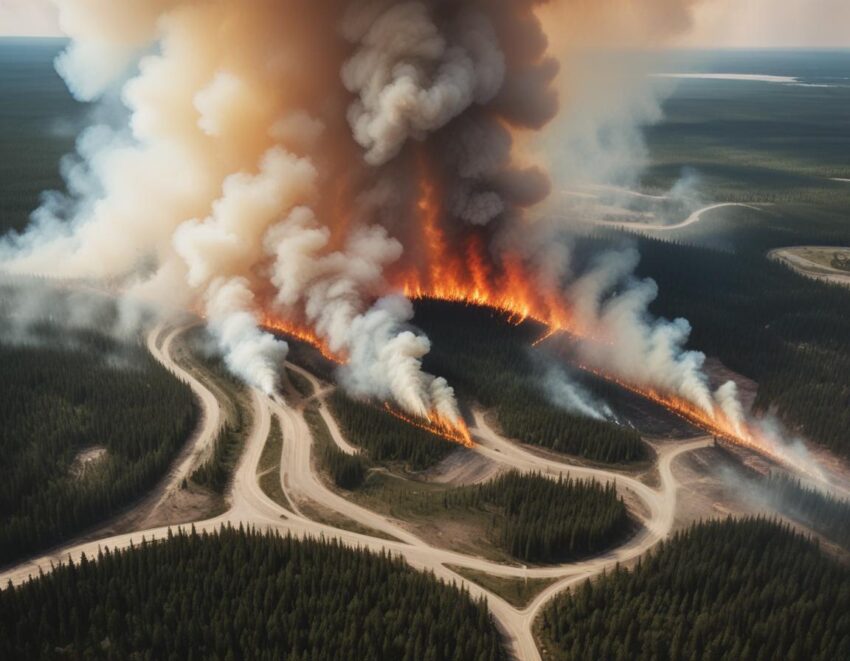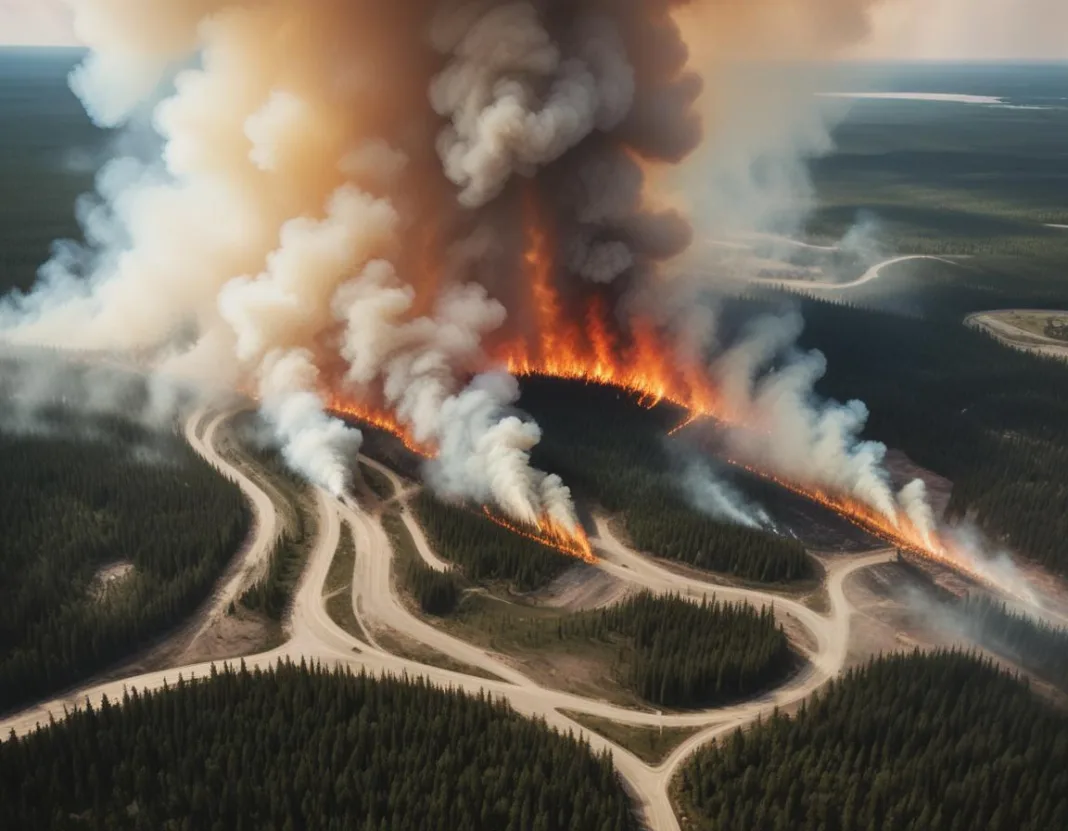Published on
August 19, 2025
By: Tuhin Sarkar

New Brunswick accordingly joins the provinces of Ontario, Québec, Manitoba, and Saskatchewan in the unprecedented battle against the worst wildfire season recorded in Canada, as the latest operational update confirms. Wildfires of record magnitude—now confirmed to represent the 2025 season—are sweeping from British Columbia eastward across the country to the Atlantic, creating a continuous front of active conflagrations. Accordingly, every affected province, from British Columbia to New Brunswick, continues to report dynamic fire behaviour. The coordinated assessment indicates a comprehensive national campaign.
New Brunswick thus stands alongside Manitoba, where hundreds of blazes remain uncontained, and Saskatchewan, where uncontrollable fires are surging atop existing fires. Québec, acting as a corridor layer, witnesses fire-generated smoke penetrating major urban centres, while Ontario applies tactical measures to safeguard extensive forested regions. The update underscores the expanding front of smoke and flame by confirming sweeping travel restrictions, closure of national parks, and disruption of tourism, travel, and outdoor attractions from coast to coast. The operational Intelligence thus confirms a wildfire season of scale and intensity not recorded in at least three decades.
Canada is on course for one of its most devastating wildfire seasons to date, occurring against the backdrop of the country’s federally designated peak-vacation period. Nationally coordinated mitigation efforts have now expanded to include New Brunswick, which alongside Ontario, Québec, Manitoba, and Saskatchewan, is implementing protective measures to safeguard communities, secure public safety for visitors, and preserve the viability of the country’s travel economy.
As of mid-August 2025, more than 7.8 million hectares have already succumbed to flame, affording 2025 the grim status of Canada’s second-worst wildfire season on record. Elevated fire fronts now bracket the country from the coastal rain forests of British Columbia to the marshy estuaries of Atlantic Canada. The rapid advance is damaging biodiversity, imposing severe disruption on logistical support grids, and placing the travel sector’s outdoor-dependent offerings at immediate risk of cancellation and reputational damage.
Ample evidence continues to affirm the intertwined relationships among climate change, modern extreme weather, and the systemic disruption of travel. 2025’s fire fronts have drifted along historically seasonally extreme temperature and humidity readings, illustrating the nexus of intensified risk. As a consequence, constrained access to iconic landscapes, curtailed regional infrastructure, and diminished traveler confidence have begun to materially affect bookings, business recovery, and the broader strength of the national travel economy.
British Columbia battles dozens of active fires
British Columbia continues to be one of the hardest-hit provinces. By August, more than 80 fires remained active across the province. The Mount Underwood fire on Vancouver Island is still out of control. The Bear Creek fire near Harrison was recently brought under control.
B.C. is a global tourism destination. Its mountains, forests, and lakes attract millions of international visitors each year. But smoke-filled skies and trail closures have left tourists cancelling trips. Popular hiking routes and campgrounds are closed under provincial restrictions. The tourism economy, especially in smaller towns, is suffering as travellers look elsewhere for safe holidays.
Alberta sees complex fire events
Alberta is also experiencing a challenging season. The Red Earth East Complex, which includes seven separate fires, remains a focus of firefighting. While most of these fires are being held or brought under control, the danger remains.
For Alberta’s tourism, uncertainty is damaging. Visitors heading to national parks such as Banff or Jasper face mixed messages. While urban areas remain safe, fires in rural regions feed global headlines that shape travel choices. Airlines, resorts, and tour operators are seeing shifts in bookings as travellers hesitate.
Saskatchewan under intense fire pressure
Saskatchewan has reported nearly 70 active fires in August. Many are not yet contained, and firefighting crews are protecting key infrastructure and communities. The Public Safety Agency continues to publish daily maps showing the status of each blaze.
This is one of the most severe wildfire years in the province’s history. The vast boreal forests, normally a draw for eco-tourists, are under threat. National parks and wilderness areas face closures. Smoke has reduced visibility and air quality across towns and highways. For travellers, this creates safety concerns and transport delays.
Manitoba reports record levels of fire activity
Manitoba has been one of the hardest-hit provinces in 2025. By August, more than 150 active wildfires were recorded. A state of emergency was declared earlier in the month. Communities have been evacuated, with the Red Cross providing support.
For Manitoba’s tourism industry, the crisis has been devastating. The province markets itself on wilderness, lakes, and wildlife. With so many fires, attractions are closed and rural travel is limited. Domestic and international visitors are cancelling trips. Hotels, restaurants, and local guides are losing vital summer income.
Ontario faces widespread fire clusters
Ontario is also under pressure. The Ministry of Natural Resources and Forestry has reported dozens of active fires across the Northwest and Northeast regions. At one point in August, 46 fires were burning in the Northwest alone.
Northern Ontario, with its lakes and forests, is a magnet for fishing, camping, and Indigenous tourism experiences. But with fire bans and closures in place, these activities are suspended. Tourism operators are pivoting to urban markets, but the loss of outdoor activity hits hard.
Quebec experiences stable but ongoing risk
Quebec is facing fewer active fires than its western neighbours. However, fire danger remains high in certain regions. SOPFEU, the provincial wildfire agency, continues to update fire maps daily. Visitors to Quebec’s wilderness areas are warned to remain cautious.
Quebec’s stability is relative. While not under the same pressure as Manitoba or Saskatchewan, the risk of flare-ups remains. For tourists, this means uncertainty when planning trips to parks or forests. The tourism industry must be ready to adapt if conditions worsen.
New Brunswick fights Miramichi fire and dozens more
New Brunswick gained global attention this month when the Miramichi-area fire burned for nearly two weeks. It spread across 1,400 hectares before being declared contained on 18 August. Bulldozers, water bombers, and rainfall helped turn the tide.
But the province is not out of danger. Thirty-five active fires remain, six of them out of control. Air quality warnings have been issued across the Miramichi region. Smoke has affected both residents and visitors. Hiking, camping, and forestry activities are banned.
For New Brunswick tourism, this is a critical blow. Atlantic Canada is marketed as a safe natural escape. With fires and smoke dominating headlines, visitor numbers are at risk.
Nova Scotia struggles with Long Lake fire
Nova Scotia continues to battle the Long Lake wildfire complex in Annapolis County. By August, the blaze had grown beyond 3,000 hectares. Parts of the fire remain out of control. Evacuations have been carried out in affected communities.
Tourism in Nova Scotia relies on summer visitors from across Canada and abroad. The wildfires have forced authorities to impose strict burn bans and trail closures. Outdoor travel is limited. The image of Nova Scotia as a summer haven is being challenged by the reality of climate-driven disasters.
Newfoundland and Labrador controls Avalon fires
Newfoundland and Labrador have also seen wildfire activity this summer. The Holyrood fire near the Avalon Peninsula was brought under control earlier in August. Restrictions on outdoor vehicle use and open fires remain in place.
While the immediate threat has eased, the tourism industry remains on alert. The Red Cross is still supporting communities affected by evacuations. Travellers to Newfoundland are being urged to monitor provincial fire updates before venturing into forested areas.
Prince Edward Island enforces burn bans
Prince Edward Island has not reported major active wildfires in August. However, the province has imposed a burn ban due to high fire danger. Residents and tourists are barred from outdoor burning.
Even without active fires, the restrictions show how vulnerable small provinces are to climate risk. P.E.I.’s tourism is heavily dependent on summer activities. Messaging around bans and restrictions has the potential to deter visitors, even if the danger is precautionary.
Northwest Territories faces widespread crisis
The Northwest Territories continue to endure one of their worst wildfire seasons. More than 100 fires are active as of mid-August. Nearly all are considered out of control. Smoke has blanketed vast regions. Highways have been closed at times. Communities have faced evacuation orders.
For tourism, the NWT’s image as a pristine northern wilderness is under threat. Smoke has reduced visibility of attractions like the aurora borealis. Parks and trails are closed. The territory faces significant challenges in rebuilding visitor confidence once the season ends.
Yukon and Nunavut watch conditions closely
Yukon continues to report scattered wildfires across its districts. Fire danger ratings remain moderate to high. Authorities issue bulletins daily to update residents and visitors. Tourism businesses are adapting by shifting focus to safer regions.
Nunavut has reported fewer local fires but has experienced smoke from other regions. Smoke advisories have been issued in South Baffin and other areas. For travellers, this creates confusion. Even if there is no fire nearby, conditions can still affect air quality and visibility.
The national impact on tourism and travel
Wildfires do not just destroy forests. They disrupt economies. Tourism is one of the sectors hardest hit. Canada markets itself on wilderness and outdoor adventure. Fires, smoke, and closures strip away that promise.
Airlines, hotels, and tour operators are all affected. Flight routes may be diverted due to smoke. Visitors cancel reservations. Parks and campsites close. The financial toll is immediate for communities that depend on short summer tourism seasons.
For international visitors, headlines about wildfires reshape perception. Canada risks being seen as a country where natural beauty is under constant threat. That image could reduce long-term tourism demand.
Climate change and the future of Canadian tourism
The wildfire crisis of 2025 is part of a bigger story. Climate change is driving hotter, drier summers. Fires are larger, longer, and harder to control. This reality will not change soon.
For Canadian tourism, adaptation is essential. Tourism boards must diversify their offerings. More investment in indoor attractions, urban experiences, and climate-resilient infrastructure is required. Without change, every summer could bring new cancellations and economic losses.
Resilience and recovery needed
Canada’s wildfire season of 2025 is shaping up to be a defining event. From British Columbia to New Brunswick, flames are testing resilience. Manitoba and Saskatchewan face some of the worst conditions. New Brunswick’s Miramichi fire is contained, but dozens more burn. The Northwest Territories face widespread devastation.
The tourism industry is at the frontline of this crisis. Outdoor adventures, campgrounds, and wilderness tours are being cancelled. Air quality warnings deter visitors. Communities dependent on seasonal tourism are suffering.
Yet resilience is possible. By investing in climate adaptation, strengthening public communication, and supporting communities, Canada can recover. But the lesson is clear. Tourism in Canada will not survive the era of climate change without preparation. The fires of 2025 are both a warning and an opportunity to build a stronger, safer future.
A province under siege from flames
New Brunswick has been fighting its worst wildfire season in decades. The Miramichi-area fire, which burned for nearly two weeks and spread across 1,400 hectares, has finally been contained. Bulldozers, water bombers, and much-needed rain gave firefighters the edge. But despite this success, 35 active wildfires continue to burn across the province. Six are considered out of control.
For tourism and travel, the consequences are immediate. Outdoor attractions are closed. Burn bans cover Crown lands. Hiking, camping, and fishing are prohibited. Crown trails and forests are off-limits. International and domestic travellers arriving in Atlantic Canada are being told to rethink their plans.
How the fires threaten tourism flows
The Miramichi fire grabbed national attention, but its containment is not the end of the story. Fires still threaten sites across the province. The Beaver Lake Stream blaze, sparked by lightning, has grown to 650 hectares. Jacquet River fires continue to burn. Hells Gate remains out of control.
For visitors, that means reduced access to New Brunswick’s wilderness, normally a draw for eco-tourists and adventure travellers. Crown land closures prevent camping in forests. Woods bans stop off-road driving and hiking. Private landowners are being asked to follow the same restrictions.
Hotels and resorts away from the fire lines remain open, but cancellations are rising. Tourists planning fishing trips, canoeing, or hiking must pivot to urban attractions. The tourism economy, already seasonal and fragile, now faces lost revenue.
Air quality warnings impact visitor health
Environment Canada has issued air quality advisories across the Miramichi region. Smoke has reduced visibility and caused eye and throat irritation. Vulnerable groups, including children, pregnant women, and older adults, are especially at risk. Residents and tourists alike are being urged to stay indoors, close windows, and limit outdoor activity.
For the travel sector, this is damaging. Air quality concerns deter families from visiting outdoor attractions. Tour operators face cancellations. Air travel remains operational, but the perception of unhealthy conditions weakens visitor confidence. Tourists want clear skies and clean air. In 2025, New Brunswick offers neither.
No evacuation orders but warnings grow louder
At present, no evacuation orders are in effect. However, residents in high-risk areas have been advised to be ready to leave on short notice. Officials distinguish between an “evacuation advisory,” which means be prepared, and an “evacuation alert,” which means leave immediately.
For the tourism sector, the uncertainty is challenging. Visitors do not want to risk sudden evacuations. Advisories alone can cause trip cancellations. Tourism operators are now recommending that visitors prepare emergency kits and stay flexible with itineraries. This advice, while practical, undermines the carefree appeal of leisure travel.
Travel restrictions and bans across the province
The government has imposed a provincewide burn ban. All outdoor fires are prohibited. Crown lands and trails are closed. Forestry operations, including harvesting and chipping, have been halted. This removes access to large sections of New Brunswick’s outdoor tourism product.
Campers are only allowed in official campgrounds, but even then officials are asking travellers to reconsider. Tourism that depends on forests—hunting lodges, nature trails, eco-parks—is effectively paused. The longer the fires last, the more severe the losses for rural tourism businesses.
Support from across Canada
Forty firefighters from Ontario have joined New Brunswick crews to fight the Beaver Lake Stream fire. Firefighters are also arriving from across the country to assist. The scale of national cooperation underscores how severe the situation has become.
For travellers, the presence of firefighting teams offers reassurance. It shows that the fires are being tackled with maximum effort. But it also highlights the seriousness of the crisis. Visitors seeing military bulldozers and water bombers realise this is not a routine summer season.
Weather helps but risks remain
Rainfall over the weekend helped contain the Miramichi fire. Cooler temperatures also eased firefighting. But officials warn the risk remains high. Quick rain showers only dampen the surface of forests. Dry material below remains flammable. Lightning from storms can also ignite new fires.
For travel planning, this creates volatility. A tourist attraction closed one week might reopen, only to close again after another lightning strike. Tourism boards are struggling to provide reliable information. The unpredictability makes it harder to attract visitors during the high summer season.
Wildlife forced into populated areas
The fires are also displacing wildlife. Moose, deer, and even bears are moving into unfamiliar areas. The province is warning people not to approach or feed animals. Drivers are being told to use caution on roads near fire zones.
For visitors, the sight of displaced wildlife may seem striking. But it also adds safety risks. Animal collisions on highways are already a concern in New Brunswick. The fires make encounters more likely. This is yet another factor complicating tourism and travel safety.
Economic and tourism impact
Tourism is a major part of New Brunswick’s economy. The wildfire crisis comes at the peak of the season, when visitors normally fill hotels and campgrounds. Businesses catering to outdoor recreation are losing revenue. Restaurants and shops near closed attractions are seeing fewer customers.
Airlines and airports have not reported closures, but cancellations of trips to New Brunswick are expected to rise if the fires persist. Perception is as damaging as reality. Even if urban areas remain safe, global headlines about “wildfires in New Brunswick” are enough to deter travellers.
Lessons for Canadian tourism policy
The New Brunswick wildfires highlight the growing link between climate change and tourism. Extreme weather events are striking more often. Heatwaves, floods, and fires disrupt travel patterns. For Atlantic Canada, which markets itself as a safe natural destination, this poses a branding challenge.
The fires also reveal the importance of public communication. Advisories, alerts, and daily updates are now critical. Tourism boards must coordinate with emergency services to reassure visitors. Without clear messaging, travellers may cancel trips unnecessarily.
Public health and safety in focus
Air quality is more than an inconvenience. It is a health risk. Tourists with asthma or heart disease are especially vulnerable. Hotels and attractions must provide clear guidance on safety. Visitors are advised to keep masks on hand, limit outdoor activity, and monitor government dashboards.
For tourism, this shifts focus. Experiences move indoors. Urban attractions like museums and cultural centres gain relevance when outdoor spaces close. But these cannot fully replace the draw of forests, trails, and rivers. The tourism product is reshaped under pressure.
Looking ahead: the path to recovery
The containment of the Miramichi fire is a victory. It shows that coordinated effort, weather breaks, and strong leadership can turn the tide. But with 35 active wildfires still burning, recovery is far off. The next weeks will determine whether New Brunswick stabilises or faces another surge of crisis.
For tourism, the path to recovery will require marketing campaigns to rebuild confidence. Visitors must be reassured that attractions are safe. Investments in firefighting capacity and climate resilience will be essential. Without them, New Brunswick risks repeat crises in future summers.
A warning and an opportunity
New Brunswick’s wildfire crisis of 2025 is a stark warning for Canada’s tourism industry. The Miramichi fire is contained, but 35 active wildfires remain. Attractions are closed, air quality is reduced, and visitors are cancelling. The province’s image as a pristine destination is under threat.
Yet it is also an opportunity. By acting decisively, New Brunswick can showcase resilience. By investing in safety and communication, it can restore trust. By linking climate action with tourism strategy, it can prepare for a future where extreme weather is no longer rare but routine.
The world is watching. Tourists will return if they see leadership, safety, and readiness. The fires of 2025 must be remembered not just as a disaster but as a turning point for Canadian tourism resilience.







